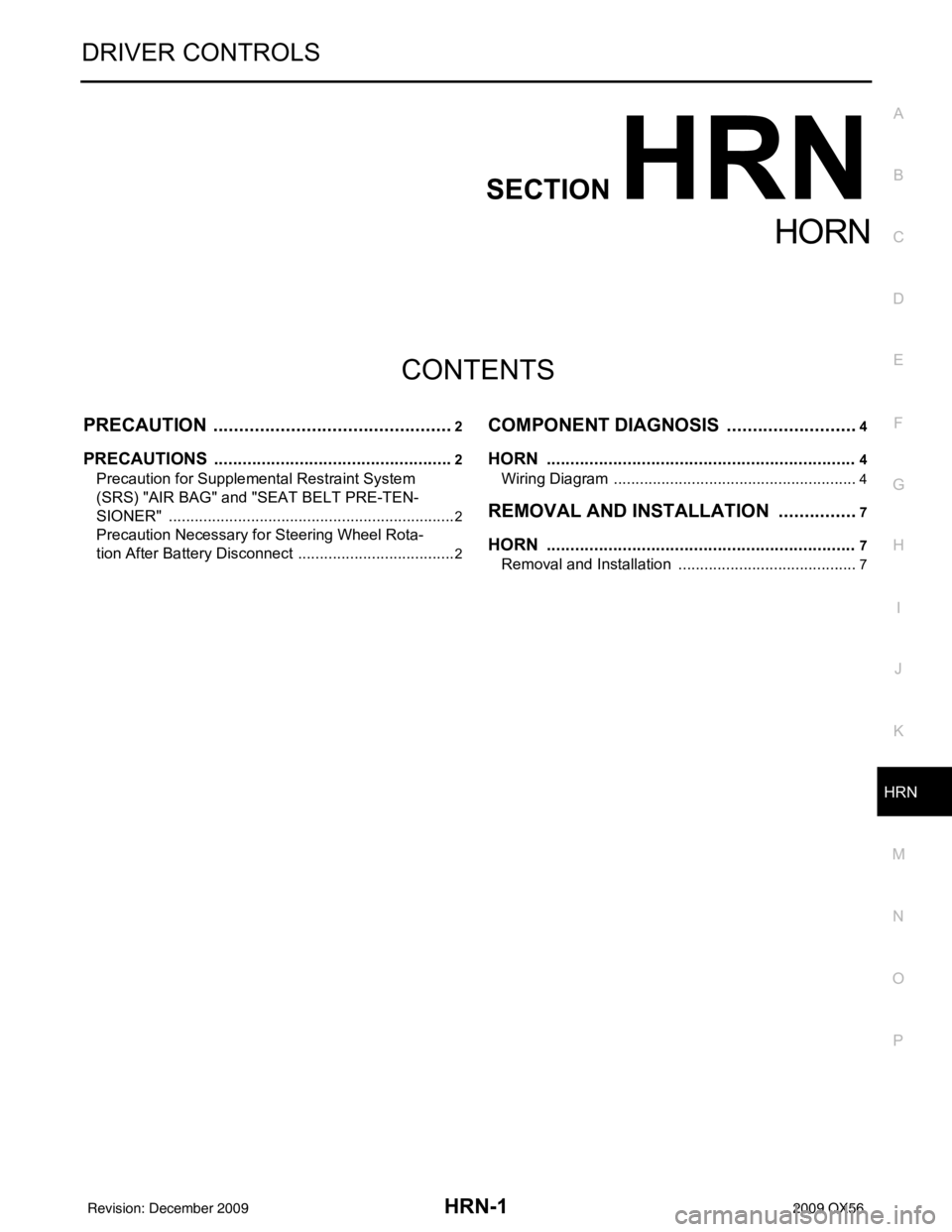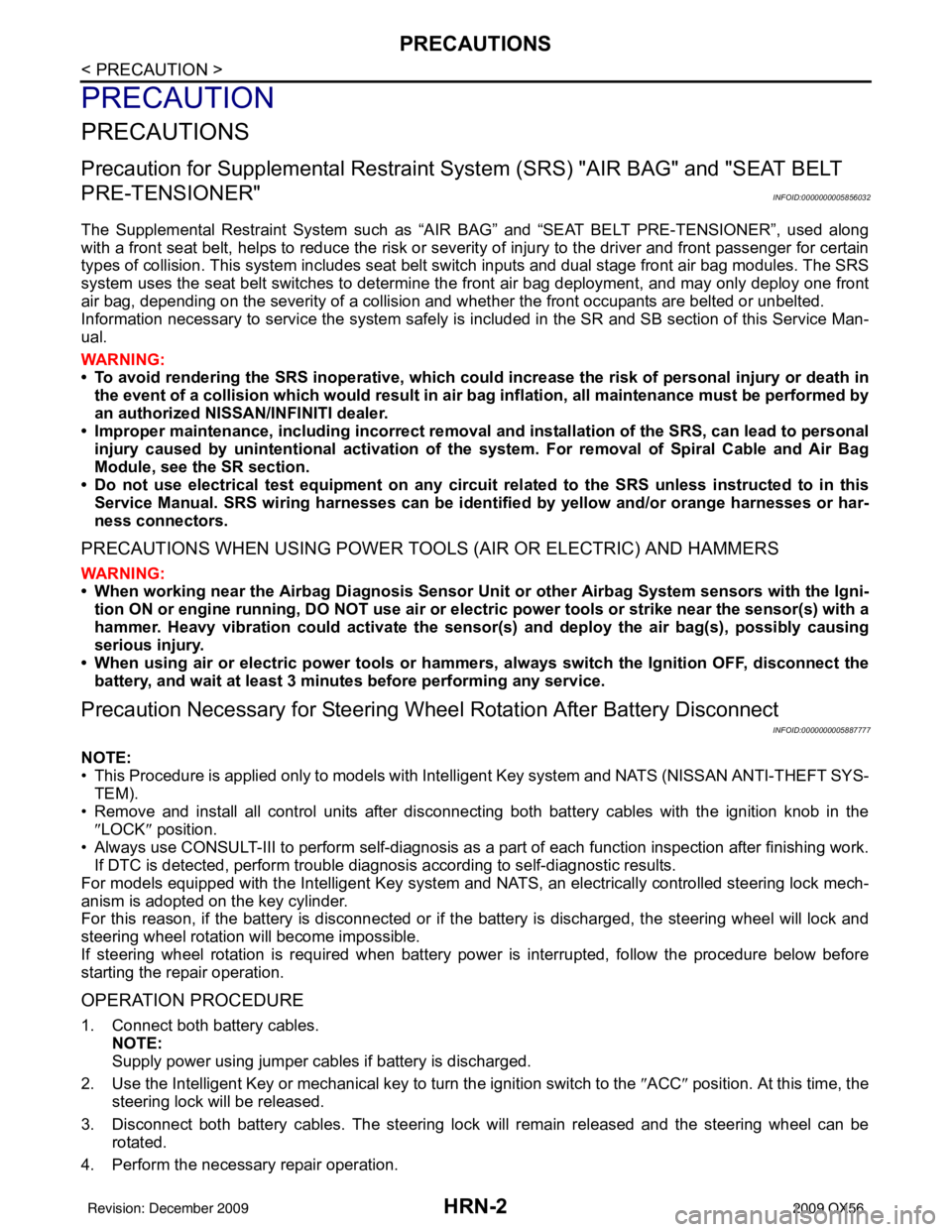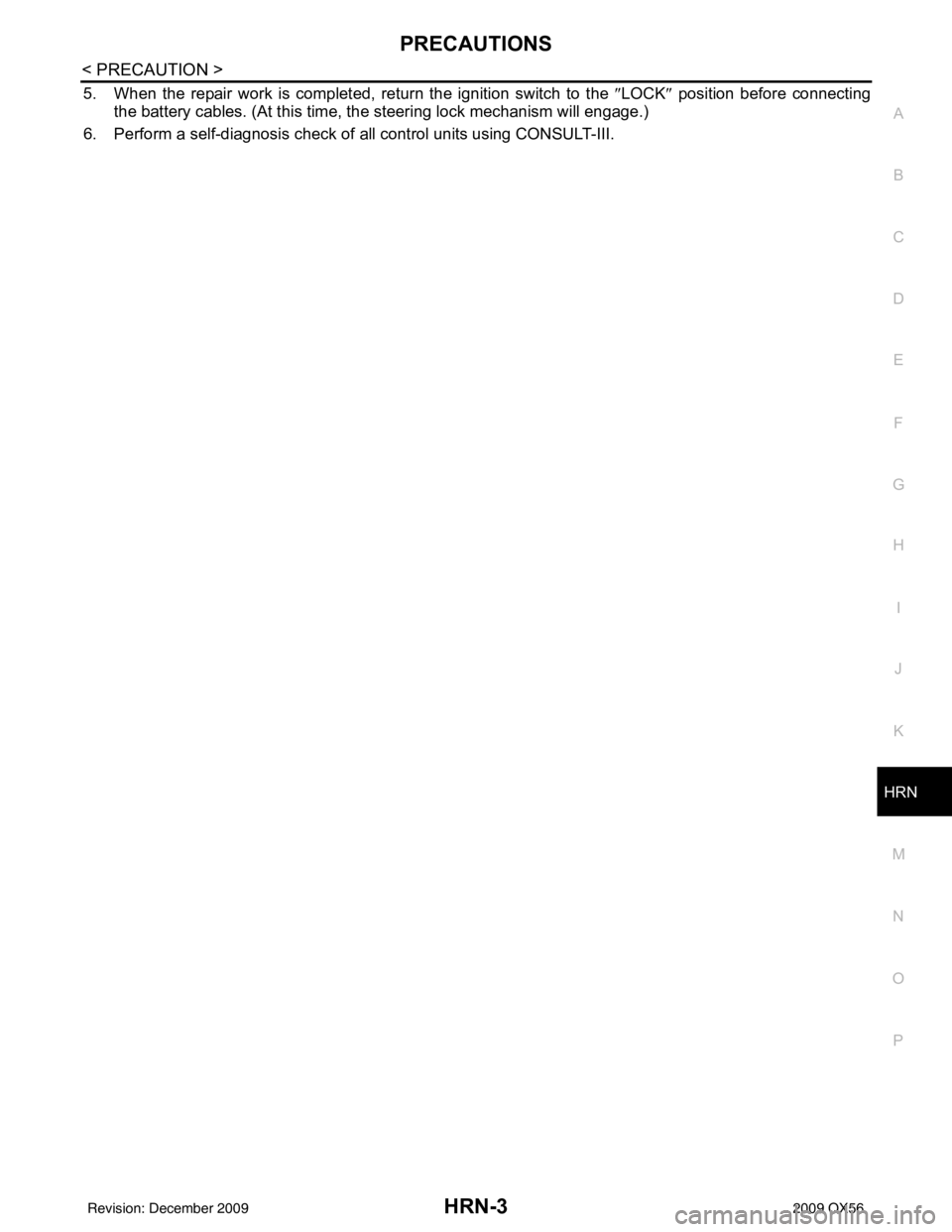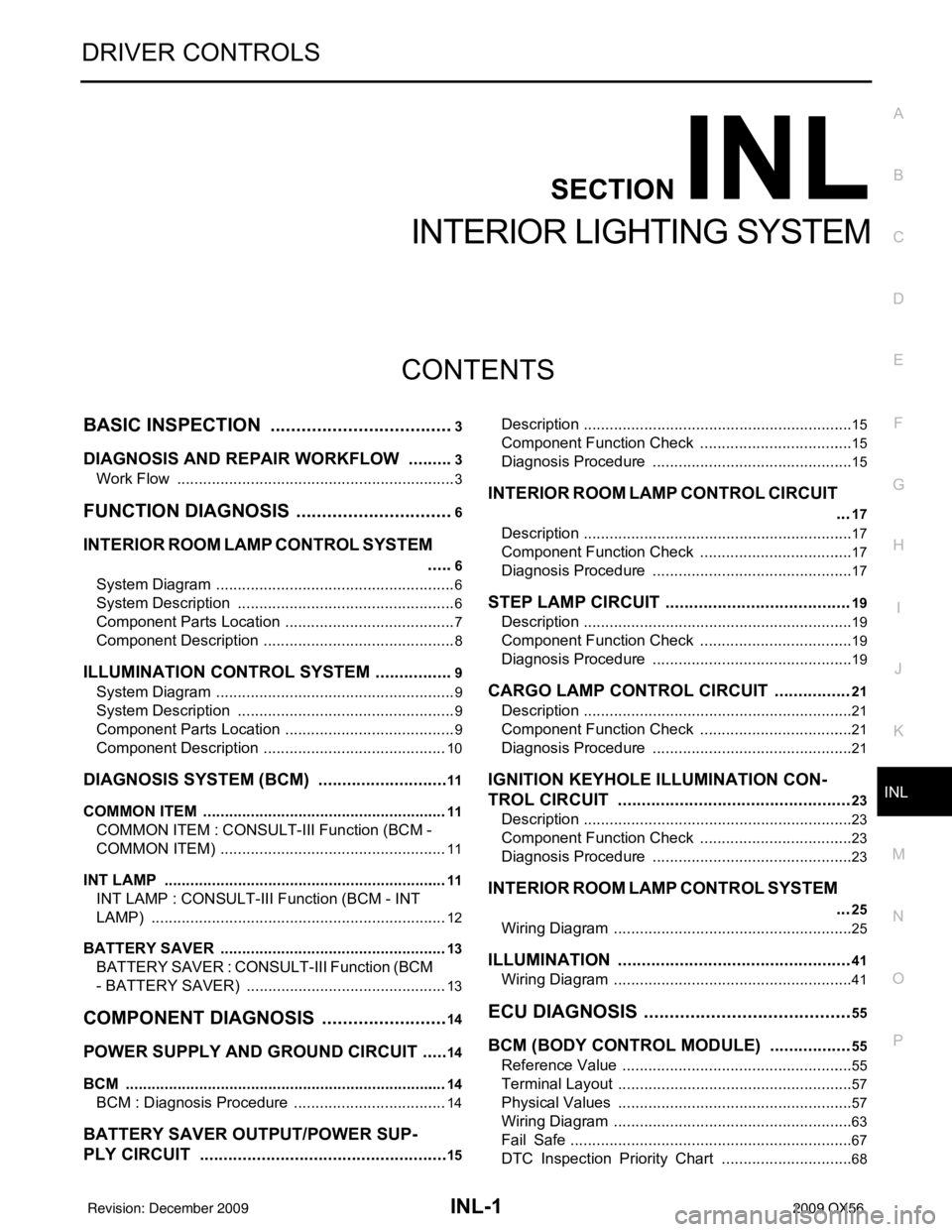2009 INFINITI QX56 battery
[x] Cancel search: batteryPage 2404 of 4171
![INFINITI QX56 2009 Factory Service Manual AIR CONDITIONER CONTROLHAC-91
< ECU DIAGNOSIS > [AUTOMATIC AIR CONDITIONER]
C
D
E
F
G H
J
K L
M A
B
HAC
N
O P
ECU DIAGNOSIS
AIR CONDITIONER CONTROL
A/C Auto Amp. Terminals Reference ValuesINFOID:00000 INFINITI QX56 2009 Factory Service Manual AIR CONDITIONER CONTROLHAC-91
< ECU DIAGNOSIS > [AUTOMATIC AIR CONDITIONER]
C
D
E
F
G H
J
K L
M A
B
HAC
N
O P
ECU DIAGNOSIS
AIR CONDITIONER CONTROL
A/C Auto Amp. Terminals Reference ValuesINFOID:00000](/manual-img/42/57031/w960_57031-2403.png)
AIR CONDITIONER CONTROLHAC-91
< ECU DIAGNOSIS > [AUTOMATIC AIR CONDITIONER]
C
D
E
F
G H
J
K L
M A
B
HAC
N
O P
ECU DIAGNOSIS
AIR CONDITIONER CONTROL
A/C Auto Amp. Terminals Reference ValuesINFOID:0000000003775388
Measure voltage between each terminal and ground by following
Terminals and Reference Value for A/C auto amp. (1).
A/C AUTO AMP. HARNESS CO NNECTOR TERMINAL LAYOUT
TERMINALS AND REFERENCE VALUES FOR A/C AUTO AMP.
AWIIA0170ZZ
AWIIA0840ZZ
Te r m i n a l No. Wire
color Item
Ignition
switch Condition
Voltage (V)
(Approx.)
1 G/O Optical sensor (driver) ON- 0 - 5V
2 L Air mix door motor (passe nger) ON-Battery voltage
3 P V ref ACTR (ground) ON- 5V
4 W/R Compressor ON signal ON A/C switch OFF
5V
ON A/C switch ON 0V
5 L/R Fan ON signal ON Blower switch OFF
5V
ON Blower switch ON 0V
6 SB Air mix door motor (driver) feedback ON -0 - 5V
7 GR Mode door motor feedback ON- 0 - 5V
8 R/L Illumination + ON Park lamps ONBattery voltage
9 BR Illumination - - Park lamps ON
10 LG/B Defroster door motor feedback ON -0 - 5V
11 L/B Intake sensor ON- 0 - 5V
12 G/Y Variable blower control (rear) ON- 0 - 5V
13 G/R Variable blower control (front) ON- 0 - 5V
PIIA2344E
Revision: December 20092009 QX56
Page 2405 of 4171
![INFINITI QX56 2009 Factory Service Manual HAC-92
< ECU DIAGNOSIS >[AUTOMATIC AIR CONDITIONER]
AIR CONDITIONER CONTROL
14 G/W Air mix door motor (passenger) CW ON Clockwise rotation
Battery voltage
15 Y/G Power supply for IGN ON- Battery volta INFINITI QX56 2009 Factory Service Manual HAC-92
< ECU DIAGNOSIS >[AUTOMATIC AIR CONDITIONER]
AIR CONDITIONER CONTROL
14 G/W Air mix door motor (passenger) CW ON Clockwise rotation
Battery voltage
15 Y/G Power supply for IGN ON- Battery volta](/manual-img/42/57031/w960_57031-2404.png)
HAC-92
< ECU DIAGNOSIS >[AUTOMATIC AIR CONDITIONER]
AIR CONDITIONER CONTROL
14 G/W Air mix door motor (passenger) CW ON Clockwise rotation
Battery voltage
15 Y/G Power supply for IGN ON- Battery voltage
17 W/G Air mix door motor (driver) CW ON Clockwise rotationBattery voltage
18 G Air mix door motor (driver) CCW ON Coun terclockwise rotationBattery voltage
19 BR/W Mode door motor CW (front) ON Clockwise rotationBattery voltage
20 P/L Mode door motor CCW ON Counterclockwise rotationBattery voltage
21 G/B Intake door motor CCW ON Counterclockwise rotationBattery voltage
22 O Intake door motor CW ON Clockwise rotationBattery voltage
23 LG Defroster door motor CW ON Clockwise rotationBattery voltage
24 P/B Defroster door motor CCW ON Counterclockwise rotationBattery voltage
25 P Ambient sensor ON- 0 - 5V
26 V/R Sensor ground ON- 0V
27 Y/R Power supply for BAT -- Battery voltage
28 Y V ref ACTR (5V) ON- 0 - 5V
29 R/W Air mix door motor (passenger) feed-
back
ON
- 0 - 5V
30 R/Y Mode door motor (Rear) feedback ON -0 - 5V
31 BR/Y In-vehicle sensor motor (+) ON- Battery voltage
32 LG/R In-vehicle sensor signal ON- 0 - 5V
33 R/Y Air mix door motor (Rear) feedback ON -0 - 5V
36 B Ground -- 0V
40 P CAN-L ON- 0 - 5V
41 L CAN-H ON- 0 - 5V
42 W/V Optical sensor (passenger) ON- 0 - 5V
43 GR/R Mode door motor (Rear) CW ON Clockwise rotationBattery voltage
44 L/Y Mode door motor (Rear) CCW ON Counterclockwise rotation Battery voltage
45 Y/L Water valve ONWater valve open
Battery voltage
Water valve closed 0V
46 W/G Water valve ONWater valve open
0V
Water valve closed Battery voltage
47 O LIN BUS (rear) ON- Battery voltage
48 O LIN BUS (front) ON- Battery voltage
49 GR/R Air mix door motor (Rear) CW ONClockwise rotation Battery voltage
50 L/Y Air mix door motor (Rear) CCW ON Counterclockwise rotation Battery voltage
Te r m i n a l
No. Wire
color ItemIgnition
switch Condition Voltage (V)
(Approx.)
Revision: December 20092009 QX56
Page 2436 of 4171
![INFINITI QX56 2009 Factory Service Manual PRECAUTIONSHAC-123
< PRECAUTION > [AUTOMATIC AIR CONDITIONER]
C
D
E
F
G H
J
K L
M A
B
HAC
N
O P
PRECAUTION
PRECAUTIONS
Precaution for Supplemental Restraint System (SRS) "AIR BAG" and "SEAT BELT
PRE INFINITI QX56 2009 Factory Service Manual PRECAUTIONSHAC-123
< PRECAUTION > [AUTOMATIC AIR CONDITIONER]
C
D
E
F
G H
J
K L
M A
B
HAC
N
O P
PRECAUTION
PRECAUTIONS
Precaution for Supplemental Restraint System (SRS) "AIR BAG" and "SEAT BELT
PRE](/manual-img/42/57031/w960_57031-2435.png)
PRECAUTIONSHAC-123
< PRECAUTION > [AUTOMATIC AIR CONDITIONER]
C
D
E
F
G H
J
K L
M A
B
HAC
N
O P
PRECAUTION
PRECAUTIONS
Precaution for Supplemental Restraint System (SRS) "AIR BAG" and "SEAT BELT
PRE-TENSIONER"
INFOID:0000000005867494
The Supplemental Restraint System such as “AIR BAG” and “SEAT BELT PRE-TENSIONER”, used along
with a front seat belt, helps to reduce the risk or severi ty of injury to the driver and front passenger for certain
types of collision. This system includes seat belt switch inputs and dual stage front air bag modules. The SRS
system uses the seat belt switches to determine the front air bag deployment, and may only deploy one front
air bag, depending on the severity of a collision and w hether the front occupants are belted or unbelted.
Information necessary to service the system safely is included in the SR and SB section of this Service Man-
ual.
WARNING:
• To avoid rendering the SRS inoper ative, which could increase the risk of personal injury or death in
the event of a collision which would result in air bag inflation, all maintenance must be performed by
an authorized NISSAN/INFINITI dealer.
• Improper maintenance, including in correct removal and installation of the SRS, can lead to personal
injury caused by unintentional act ivation of the system. For removal of Spiral Cable and Air Bag
Module, see the SR section.
• Do not use electrical test equipm ent on any circuit related to the SRS unless instructed to in this
Service Manual. SRS wiring harnesses can be identi fied by yellow and/or orange harnesses or har-
ness connectors.
PRECAUTIONS WHEN USING POWER TOOLS (AIR OR ELECTRIC) AND HAMMERS
WARNING:
• When working near the Airbag Diagnosis Sensor Un it or other Airbag System sensors with the Igni-
tion ON or engine running, DO NOT use air or el ectric power tools or strike near the sensor(s) with a
hammer. Heavy vibration could activate the sensor( s) and deploy the air bag(s), possibly causing
serious injury.
• When using air or electric power tools or hammers, always switch the Ignition OFF, disconnect the battery, and wait at least 3 minutes before performing any service.
Working with HFC-134a (R-134a)INFOID:0000000003775400
WARNING:
• CFC-12 (R-12) refrigerant and HFC-134a (R-134a) refr igerant are not compatible. If the refrigerants
are mixed compressor failure is likely to occur. Refer to HA-4, "
Contaminated Refrigerant". To deter-
mine the purity of HFC-134a (R-134a) in the vehic le and recovery tank, use Refrigerant Recovery/
Recycling Recharging equipment and Refrigerant Identifier.
• Use only specified oil for the HFC-134a (R-134a) A/C system and HFC-134a (R-134a) components. If oil other than that specified is used, compressor fa ilure is likely to occur.
• The specified HFC-134a (R-134a) oil rapidly absorb s moisture from the atmosphere. The following
handling precautions must be observed:
- When removing refrigerant components from a vehicle, immediately cap (seal) the component to
minimize the entry of mois ture from the atmosphere.
- When installing refrigerant components to a vehicle, do not remove the caps (unseal) until just
before connecting the co mponents. Connect all refrigerant lo op components as quickly as possible
to minimize the entry of moisture into system.
- Only use the specified oil from a sealed container. Immediately r eseal containers of oil. Without
proper sealing, oil will become moisture saturat ed and should not be used.
- Avoid breathing A/C refrigerant and oil vapor or mist. Exposure may irritate eyes, nose and throat.
Remove HFC-134a (R-134a) from the A/C system usi ng certified service equipment meeting require-
ments of SAE J2210 [HFC-134a (R-134a) recycling equipment], or J2209 [HFC-134a (R-134a) recy-
cling equipment], If accidental system discharge occurs, ventilate work area before resuming
service. Additional health and safety information may be obtained from refrigerant and oil manufac-
turers.
- Do not allow A/C oil to come in contact with styrofoam parts. Damage may result.
CONTAMINATED REFRIGERANT
Revision: December 20092009 QX56
Page 2438 of 4171

HRN-1
DRIVER CONTROLS
C
DE
F
G H
I
J
K
M
SECTION HRN
A
B
HRN
N
O P
CONTENTS
HORN
PRECAUTION ....... ........................................2
PRECAUTIONS .............................................. .....2
Precaution for Supplemental Restraint System
(SRS) "AIR BAG" and "SEAT BELT PRE-TEN-
SIONER" ............................................................. ......
2
Precaution Necessary for Steering Wheel Rota-
tion After Battery Disconnect ............................... ......
2
COMPONENT DIAGNOSIS ..........................4
HORN .................................................................4
Wiring Diagram .................................................... .....4
REMOVAL AND INSTALLATION ................7
HORN .................................................................7
Removal and Installation ..................................... .....7
Revision: December 20092009 QX56
Page 2439 of 4171

HRN-2
< PRECAUTION >
PRECAUTIONS
PRECAUTION
PRECAUTIONS
Precaution for Supplemental Restraint System (SRS) "AIR BAG" and "SEAT BELT
PRE-TENSIONER"
INFOID:0000000005856032
The Supplemental Restraint System such as “A IR BAG” and “SEAT BELT PRE-TENSIONER”, used along
with a front seat belt, helps to reduce the risk or severity of injury to the driver and front passenger for certain
types of collision. This system includes seat belt switch inputs and dual stage front air bag modules. The SRS
system uses the seat belt switches to determine the front air bag deployment, and may only deploy one front
air bag, depending on the severity of a collision and w hether the front occupants are belted or unbelted.
Information necessary to service the system safely is included in the SR and SB section of this Service Man-
ual.
WARNING:
• To avoid rendering the SRS inopera tive, which could increase the risk of personal injury or death in
the event of a collision which would result in air bag inflation, all maintenance must be performed by
an authorized NISSAN/INFINITI dealer.
• Improper maintenance, including in correct removal and installation of the SRS, can lead to personal
injury caused by unintent ional activation of the system. For re moval of Spiral Cable and Air Bag
Module, see the SR section.
• Do not use electrical test equipmen t on any circuit related to the SRS unless instructed to in this
Service Manual. SRS wiring harn esses can be identified by yellow and/or orange harnesses or har-
ness connectors.
PRECAUTIONS WHEN USING POWER TOOLS (AIR OR ELECTRIC) AND HAMMERS
WARNING:
• When working near the Airbag Diagnosis Sensor Unit or other Airbag System sensors with the Igni-
tion ON or engine running, DO NOT use air or electri c power tools or strike near the sensor(s) with a
hammer. Heavy vibration could activate the sensor( s) and deploy the air bag(s), possibly causing
serious injury.
• When using air or electric power tools or hammers , always switch the Ignition OFF, disconnect the
battery, and wait at least 3 minu tes before performing any service.
Precaution Necessary for Steering W heel Rotation After Battery Disconnect
INFOID:0000000005887777
NOTE:
• This Procedure is applied only to models with Intelligent Key system and NATS (NISSAN ANTI-THEFT SYS-
TEM).
• Remove and install all control units after disconnecting both battery cables with the ignition knob in the
″LOCK ″ position.
• Always use CONSULT-III to perform self-diagnosis as a part of each function inspection after finishing work.
If DTC is detected, perform trouble diagnosis according to self-diagnostic results.
For models equipped with the Intelligent Key system and NATS, an electrically controlled steering lock mech-
anism is adopted on the key cylinder.
For this reason, if the battery is disconnected or if the battery is discharged, the steering wheel will lock and
steering wheel rotation will become impossible.
If steering wheel rotation is required when battery pow er is interrupted, follow the procedure below before
starting the repair operation.
OPERATION PROCEDURE
1. Connect both battery cables. NOTE:
Supply power using jumper cables if battery is discharged.
2. Use the Intelligent Key or mechanical key to turn the ignition switch to the ″ACC ″ position. At this time, the
steering lock will be released.
3. Disconnect both battery cables. The steering lock will remain released and the steering wheel can be rotated.
4. Perform the necessary repair operation.
Revision: December 20092009 QX56
Page 2440 of 4171

PRECAUTIONSHRN-3
< PRECAUTION >
C
DE
F
G H
I
J
K
M A
B
HRN
N
O P
5. When the repair work is completed, return the ignition switch to the ″LOCK ″ position before connecting
the battery cables. (At this time, the steering lock mechanism will engage.)
6. Perform a self-diagnosis check of al l control units using CONSULT-III.
Revision: December 20092009 QX56
Page 2445 of 4171

INL-1
DRIVER CONTROLS
C
DE
F
G H
I
J
K
M
SECTION INL
A
B
INL
N
O P
CONTENTS
INTERIOR LIGHTING SYSTEM
BASIC INSPECTION ....... .............................3
DIAGNOSIS AND REPAIR WORKFLOW ..... .....3
Work Flow ........................................................... ......3
FUNCTION DIAGNOSIS ...............................6
INTERIOR ROOM LAMP CONTROL SYSTEM
.....
6
System Diagram .................................................. ......6
System Description ...................................................6
Component Parts Location ........................................7
Component Description .............................................8
ILLUMINATION CONTROL SYSTEM .................9
System Diagram .................................................. ......9
System Description ...................................................9
Component Parts Location ........................................9
Component Description ...........................................10
DIAGNOSIS SYSTEM (BCM) ............................11
COMMON ITEM ..................................................... ....11
COMMON ITEM : CONSULT-III Function (BCM -
COMMON ITEM) .....................................................
11
INT LAMP .............................................................. ....11
INT LAMP : CONSULT-III Function (BCM - INT
LAMP) .....................................................................
12
BATTERY SAVER ................................................. ....13
BATTERY SAVER : CONSULT-III Function (BCM
- BATTERY SAVER) ...............................................
13
COMPONENT DIAGNOSIS .........................14
POWER SUPPLY AND GROUND CIRCUIT .. ....14
BCM ....................................................................... ....14
BCM : Diagnosis Procedure ....................................14
BATTERY SAVER OUTPUT/POWER SUP-
PLY CIRCUIT ................................................. ....
15
Description ........................................................... ....15
Component Function Check ....................................15
Diagnosis Procedure ...............................................15
INTERIOR ROOM LAMP CONTROL CIRCUIT
...
17
Description ........................................................... ....17
Component Function Check ....................................17
Diagnosis Procedure ...............................................17
STEP LAMP CIRCUIT .......................................19
Description ........................................................... ....19
Component Function Check ....................................19
Diagnosis Procedure ...............................................19
CARGO LAMP CONTROL CIRCUIT ................21
Description ...............................................................21
Component Function Check ....................................21
Diagnosis Procedure ...............................................21
IGNITION KEYHOLE ILLUMINATION CON-
TROL CIRCUIT .................................................
23
Description ...............................................................23
Component Function Check ....................................23
Diagnosis Procedure ...............................................23
INTERIOR ROOM LAMP CONTROL SYSTEM
...
25
Wiring Diagram .................................................... ....25
ILLUMINATION .................................................41
Wiring Diagram ........................................................41
ECU DIAGNOSIS .........................................55
BCM (BODY CONTROL MODULE) .................55
Reference Value .................................................. ....55
Terminal Layout .......................................................57
Physical Values ................................................... ....57
Wiring Diagram ........................................................63
Fail Safe ..................................................................67
DTC Inspection Priority Chart ...............................68
Revision: December 20092009 QX56
Page 2446 of 4171

INL-2
DTC Index ..............................................................68
SYMPTOM DIAGNOSIS .............................70
INTERIOR LIGHTING SYSTEM SYMPTOMS ...70
Symptom Table ................................................... ...70
PRECAUTION .............................................71
PRECAUTIONS .............................................. ...71
Precaution for Supplemental Restraint System
(SRS) "AIR BAG" and "SEAT BELT PRE-TEN-
SIONER" .............................................................. ...
71
Precaution Necessary for Steering Wheel Rota-
tion After Battery Disconnect ..................................
71
General precautions for service operations ......... ...72
ON-VEHICLE REPAIR ...............................73
INTERIOR ROOM LAMP ................................ ...73
Removal and Installation .........................................73
ILLUMINATION .............................................. ...77
Removal and Installation .........................................77
SERVICE DATA AND SPECIFICATIONS
(SDS) .......... ................................. ...............
79
BULB SPECIFICATIONS ............................... ...79
Interior Lamp/Illumination ........................................79
Revision: December 20092009 QX56